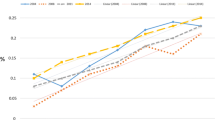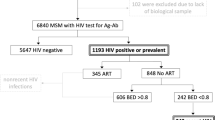Abstract
In a cross-sectional study, MSM aged ≥18 years were venue-sampled in New York City in 2008, interviewed, and tested for HIV using oral fluids. Participants who reported testing HIV negative at their last test in the previous 24 months were analyzed (n = 287 of 550 sampled). Those testing positive at the interview were defined as recently infected. HIV incidence was estimated using person-time at-risk methods and correlates of recent infection using proportional hazards regression. Thirty-two (11.1%) were recently infected. HIV incidence was 5.67/100 person-years at-risk. Independent correlates included: study recruitment in parks vs. bars, and in other venues vs. bars; black vs. non-black race/ethnicity; and reporting a last sex partner with a positive or unknown vs. negative HIV status. When assay-based methods are not feasible, cross-sectional HIV test results and self-reported HIV testing history and risk factor data can be used to estimate HIV incidence and the correlates of recent infection.
Resumen
En un estudio transversal, muestras de HSH de edad ≥ 18 años fueron obtenidas en lugares de encuentro en la ciudad de Nueva York en el 2008, entrevistados, y examinados para el VIH a través de fluidos orales. Los participantes que reportaron una prueba de VIH negativa en su última prueba en los últimos 24 meses fueron analizados (n = 287 de 550 muestras). Los que resultaron positivos en la entrevista fueron definidos como recientemente infectados. La incidencia del VIH se estima a través de métodos categorizados como persona-tiempo en-riesgo y correlaciones de infecciones recientes usando un modelo de los riesgos proporcionales. Treinta y dos (11,1%) se han infectado recientemente. La incidencia del VIH equivale a 5.67/100 personas-años en-riesgo. Correlaciones de infecciones recientes incluyen: reclutamiento para el estudio en parques vs. bares, y en otros lugares vs. bares; raza o origen étnico negra vs. no negra; y reporte de su última pareja sexual VIH positiva o de estado desconocido vs. estado de VIH negativo. Cuando métodos basados en ensayos no son factibles, resultados de VIH obtenidos de estudios transversales e historial auto reportado de exámenes de VIH y datos de factor de riesgo pueden ser utilizados para estimar la incidencia del VIH y las correlaciones de infecciones recientes.
Similar content being viewed by others
References
Centers for Disease Control and Prevention. HIV/AIDS Surveillance Report, 2009. 21. 2011. Atlanta, GA, US Department of Health and Human Services, Centers for Disease Control and Prevention.
Prejean J, Song R, Hernandez A, Ziebell R, Green T, Walker F, et al. Estimated HIV Incidence in the United States, 2006–2009. PLoS One. 2011;6(8):e17502.
Koblin BA, Husnik MJ, Colfax G, Huang Y, Madison M, Mayer K, et al. Risk factors for HIV infection among men who have sex with men. AIDS. 2006;20(5):731–9.
Kral AH, Bluthenthal RN, Lorvick J, Gee L, Bacchetti P, Edlin BR. Sexual transmission of HIV-1 among injection drug users in San Francisco, USA: risk-factor analysis. Lancet. 2001;357(9266):1397–401.
Hall HI, Song R, Rhodes P, Prejean J, An Q, Lee LM, et al. Estimation of HIV incidence in the United States. JAMA. 2008;300(5):520–9.
Kellogg TA, Loeb L, Dilley J, Adler B, Louie BT, McFarland W. Comparison of three methods to measure HIV incidence among persons seeking voluntary, anonymous counseling and testing. J Acquir Immune Defic Syndr. 2005;39(1):112–20.
Le Vu S, Pillonel J, Semaille C, Bernillon P, Le Strat Y, Meyer L, et al. Principles and uses of HIV incidence estimation from recent infection testing–a review. Euro Surveill. 2008;13(36):11–6.
MacKellar DA, Gallagher KM, Finlayson T, Sanchez T, Lansky A, Sullivan PS. Surveillance of HIV risk and prevention behaviors of men who have sex with men–a national application of venue-based, time-space sampling. Public Health Rep. 2007;122(Suppl 1):39–47.
Sifakis F, Hylton JB, Flynn C, Solomon L, MacKellar DA, Valleroy LA, et al. Racial disparities in HIV incidence among young men who have sex with men: the Baltimore Young Men’s Survey. J Acquir Immune Defic Syndr. 2007;46(3):343–8.
Torian LV, Makki HA, Menzies IB, Murrill CS, Weisfuse IB. HIV infection in men who have sex with men, New York City Department of Health sexually transmitted disease clinics, 1990-1999: a decade of serosurveillance finds that racial disparities and associations between HIV and gonorrhea persist. Sex Transm Dis. 2002;29(2):73–8.
Celentano DD, Sifakis F, Hylton J, Torian LV, Guillin V, Koblin BA. Race/ethnic differences in HIV prevalence and risks among adolescent and young adult men who have sex with men. J Urban Health. 2005;82(4):610–21.
Millett GA, Peterson JL, Wolitski RJ, Stall R. Greater risk for HIV infection of black men who have sex with men: a critical literature review. Am J Public Health. 2006;96(6):1007–19.
Bingham TA, Harawa NT, Johnson DF, Secura GM, MacKellar DA, Valleroy LA. The effect of partner characteristics on HIV infection among African American men who have sex with men in the Young Men’s Survey, Los Angeles, 1999–2000. AIDS Educ Prev. 2003;15(1 Suppl A):39–52.
Hallfors DD, Iritani BJ, Miller WC, Bauer DJ. Sexual and drug behavior patterns and HIV and STD racial disparities: the need for new directions. Am J Public Health. 2007;97(1):125–32.
Rothenberg R. HIV transmission networks. Curr Opin HIV AIDS. 2009;4(4):260–5.
Thiede H, Jenkins RA, Carey JW, Hutcheson R, Thomas KK, Stall RD, et al. Determinants of recent HIV infection among Seattle-area men who have sex with men. Am J Public Health. 2009;99(Suppl 1):157–64.
Reidy WJ, Spielberg F, Wood R, Binson D, Woods WJ, Goldbaum GM. HIV risk associated with gay bathhouses and sex clubs: findings from 2 Seattle surveys of factors related to HIV and sexually transmitted infections. Am J Public Health. 2009;99(Suppl 1):165–72.
Wasserheit JN. Epidemiological synergy. Interrelationships between human immunodeficiency virus infection and other sexually transmitted diseases. Sex Transm Dis. 1992;19(2):61–77.
Gallagher KM, Sullivan PS, Lansky A, Onorato IM. Behavioral surveillance among people at risk for HIV infection in the U.S.: the National HIV Behavioral Surveillance System. Public Health Rep. 2007;122(Suppl 1):32–8.
Lansky A, Sullivan PS, Gallagher KM, Fleming PL. HIV behavioral surveillance in the U.S.: a conceptual framework. Public Health Rep. 2007;122(Suppl 1):16–23.
Jenness SM, Neaigus A, Murrill CS, Gelpi-Acosta C, Wendel W, Hagan H. Recruitment-adjusted estimates of HIV prevalence and risk among men who have sex with men: effects of weighting venue-based sampling data. Public Health Rep. 2011;126(5):635–42.
McFarland W, Kellogg TA, Dilley J, Katz MH. Estimation of human immunodeficiency virus (HIV) seroincidence among repeat anonymous testers in San Francisco. Am J Epidemiol. 1997;146(8):662–4.
Centers for Disease Control and Prevention (CDC). HIV incidence among young men who have sex with men–seven U.S. cities, 1994–2000. MMWR Morb Mortal Wkly Rep. 2001;50(21):440–4.
Kelly JA, Sikkema KJ, Winett RA, Solomon LJ, Roffman RA, Heckman TG, et al. Factors predicting continued high-risk behavior among gay men in small cities: psychological, behavioral, and demographic characteristics related to unsafe sex. J Consult Clin Psychol. 1995;63(1):101–7.
Nash D, Bennani Y, Ramaswamy C, Torian L. Estimates of HIV incidence among persons testing for HIV using the sensitive/less sensitive enzyme immunoassy, New York City, 2001. J Acquir Immune Defic Syndr. 2005;39(1):102-11.
Centers for Disease Control and Prevention. Trends in HIV/AIDS diagnoses among men who have sex with men—33 States, 2001–2006. MMWR 57[25], 2008;681–6.
Grulich AE, Kaldor JM. Trends in HIV incidence in homosexual men in developed countries. Sex Health. 2008;5(2):113–8.
Xia Q, Nonoyama A, Molitor F, Webb D, Osmond D. Recent decline in the incidence of human immunodeficiency virus infection among california men who have sex with men. Am J Epidemiol. 2011;174(2):203–10.
Ford K, Norris A. Sexual networks of African-American and Hispanic youth. Sex Transm Dis. 1997;24(6):327–33.
Carey JW, Mejia R, Bingham T, Ciesielski C, Gelaude D, Herbst JH, et al. Drug use, high-risk sex behaviors, and increased risk for recent HIV infection among men who have sex with men in Chicago and Los Angeles. AIDS Behav. 2009;13(6):1084–96.
Sullivan PS, Salazar L, Buchbinder S, Sanchez TH. Estimating the proportion of HIV transmissions from main sex partners among men who have sex with men in five US cities. AIDS. 2009;23(9):1153–62.
Sherman SG, Latkin CA. Intimate relationship characteristics associated with condom use among drug users and their sex partners: a multilevel analysis. Drug Alcohol Depend. 2001;64(1):97–104.
Neaigus A, Friedman SR, Goldstein MF, Ildefonso G, Curtis R, Jose B. Using dyadic data for a network analysis of HIV infection and risk behaviors among injecting drug users. NIDA Res Monogr. 1995;151:20–37.
Morris M, Kretzschmar M. Concurrent partnerships and the spread of HIV. AIDS. 1997;11(5):641–8.
Colfax GN, Buchbinder SP, Cornelisse PG, Vittinghoff E, Mayer K, Celum C. Sexual risk behaviors and implications for secondary HIV transmission during and after HIV seroconversion. AIDS. 2002;16(11):1529–35.
Parsons JT, Schrimshaw EW, Bimbi DS, Wolitski RJ, Gomez CA, Halkitis PN. Consistent, inconsistent, and non-disclosure to casual sexual partners among HIV-seropositive gay and bisexual men. AIDS. 2005;19(Suppl 1):587–97.
Marks G, Crepaz N. HIV-positive men’s sexual practices in the context of self-disclosure of HIV status. J Acquir Immune Defic Syndr. 2001;27(1):79–85.
Centers for Disease Control and Prevention. HIV prevalence, unrecognized infection, and HIV testing among men who have sex with men—five U.S. cities, June 2004–April 2005. MMWR Morb Mortal Wkly Rep. 2005;54(24):597–601.
Marks G, Crepaz N, Senterfitt JW, Janssen RS. Meta-analysis of high-risk sexual behavior in persons aware and unaware they are infected with HIV in the United States: implications for HIV prevention programs. J Acquir Immune Defic Syndr. 2005;39(4):446–53.
Acknowledgments
The authors would like to acknowledge Colin Shepard and James Hadler of the New York City Department of Health and Mental Hygiene for critical comments on the intellectual content in earlier drafts of the paper. We would like to thank Elizabeth DiNenno, Amy Drake, Amy Lansky, and Isa Miles of the CDC for contributing to the NHBS study design locally and nationally, and the New York City NHBS field staff for their efforts in data collection, as well as the study participants who consented to be in the study. Marlyn Duarte, Rodolfo Gutierez and Michael Navejas contributed to the Spanish translation of the abstract. This work was funded by a cooperative agreement between the New York City Department of Health and Mental Hygiene and the Centers for Disease Control and Prevention (Grant #U62/CCU223595-03-1).
Conflicts of interest
None of the authors have any conflicts of interest.
Author information
Authors and Affiliations
Corresponding author
Rights and permissions
About this article
Cite this article
Neaigus, A., Jenness, S.M., Hagan, H. et al. Estimating HIV Incidence and the Correlates of Recent Infection in Venue-Sampled Men Who Have Sex With Men in New York City. AIDS Behav 16, 516–524 (2012). https://doi.org/10.1007/s10461-011-0050-8
Published:
Issue Date:
DOI: https://doi.org/10.1007/s10461-011-0050-8




